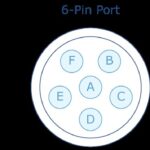Anti-lock braking systems (ABS) are crucial for vehicle safety, preventing wheel lockup during hard braking. When issues arise with your ABS, a prompt diagnosis is essential. One common question is whether a standard OBD2 scanner can detect ABS trouble codes. Let’s explore this topic in detail.
While OBD2 scanners are designed to retrieve diagnostic trouble codes (DTCs) from various vehicle systems, their ability to read ABS codes isn’t always guaranteed. OBD2 primarily focuses on powertrain-related systems, impacting emissions and fuel efficiency. ABS, being a safety system, sometimes utilizes a separate communication protocol.
Several factors determine whether your OBD2 scanner will display ABS codes:
-
Vehicle Year: OBD2 became mandatory for all gasoline vehicles sold in the United States starting in 1996. However, the inclusion of ABS code retrieval within the OBD2 standard wasn’t universally enforced. Vehicles manufactured before this year, or even some early OBD2 compliant models, might not support ABS code reading through the standard OBD2 port.
-
Scanner Capabilities: Not all OBD2 scanners are created equal. Basic code readers might only access generic powertrain codes. To retrieve ABS-specific codes, you’ll likely need an enhanced or professional-grade scan tool with manufacturer-specific capabilities. These advanced scanners can communicate with the ABS module directly, providing detailed diagnostic information.
-
Vehicle Make and Model: Different manufacturers may implement ABS diagnostics differently. Some manufacturers fully integrate ABS codes into the standard OBD2 system, while others use proprietary protocols requiring specialized software or equipment. European vehicles, for example, often require specific diagnostic tools.
One example of ABS diagnostics involves examining the Electronic Brake Control Module (EBCM). Moisture intrusion can damage the EBCM circuit board, leading to ABS malfunction and triggering trouble codes. Repairing the EBCM, including resealing the circuit board and resoldering connections, can potentially resolve these issues. Accessing the EBCM often requires specialized tools like a T20 Torx bit and careful disassembly to avoid further damage.
It’s important to consult your vehicle’s repair manual or a qualified mechanic to determine the specific diagnostic procedures for your ABS system. If you suspect an ABS problem, attempting a DIY repair might be feasible for experienced individuals. However, given the safety-critical nature of ABS, seeking professional help is often the recommended course of action.
In conclusion, while OBD2 scanners can be valuable diagnostic tools, their capacity to show ABS codes depends on various factors. The vehicle’s year, make, model, and the scanner’s capabilities all play a role. For a definitive answer, consult your vehicle’s documentation or a qualified technician. Using the correct diagnostic approach ensures accurate identification and resolution of ABS issues, maintaining the safety and reliability of your vehicle.


